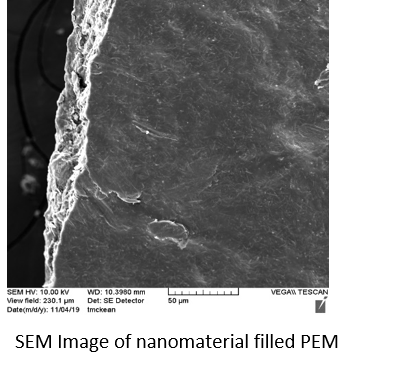Reduced Graphene Oxide-Nanosheet/Polybenzimidazole Composite Membranes for High Temperature Proton Exchange Membrane Fuel Cell Applications
Student: Thomas McKean III
Degree: M.S., August 2020
Major Professor: Dr. Ryan Tian
Research Area(s):
Nanoscience & Engineering
Conventional Materials & Processes
Background/Relevance
-
Increasing the operating temperature of proton exchange membrane fuel cells (PEMFC) will increase efficiency and enable the development of less expensive materials
-
Nanomaterial filler in the PEM introduces additional proton conductivity and reduces degradation caused by the phosphoric acid (PA) proton transport medium, increasing the durability and performance of the PEMFC
Innovation
- Boosted proton conductivity of reduced graphene oxide(RGO)-based composite nanomaterial offers superior acid resistance, proton conduction, and mechanical reinforcement
Approach
- Hydrothermally synthesize proton conductive RGO nanomaterial composite, including additional functionalization for increased proton conductivity and nano-blending
- Drop cast PBI PEMs containing a range of concentrations of nanomaterial filler and observe their PA uptake
- Characterize the mechanical properties and proton conductivities of PEM’s over a range of nanomaterial content, PA content and temperatures
- Create membrane electrode assembly (MEA) using new PEM’s to test PEMFC performance.
Key Results
- RGO composite and subsequent protonation to introduce proton conductivity successfully performed
- Strong nano-blending between PBI and RGO composite confirmed
- New PEMs with different filler concentrations formed, further optimization ongoing

Conclusions
-
A proton-rich RGO composite nanomaterial with great PEM filler potential can be hydrothermally synthesized at a low cost
-
The nano-blending between PBI and RGO can be optimized to effectively mass produce advanced PEMs
Future Work
-
Synthesize composite nanomaterial using functionalized RGO
-
Investigate the filler’s ability to increase the mechanical properties of the membrane and decrease acid leeching
-
Quantify the proton conductivity and test MEA performance at different temperatures and PA loadings
-
Assess the potential to form RGO composites with advanced proton conducting materials
